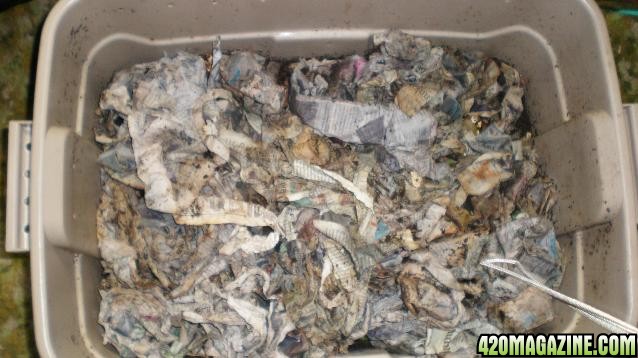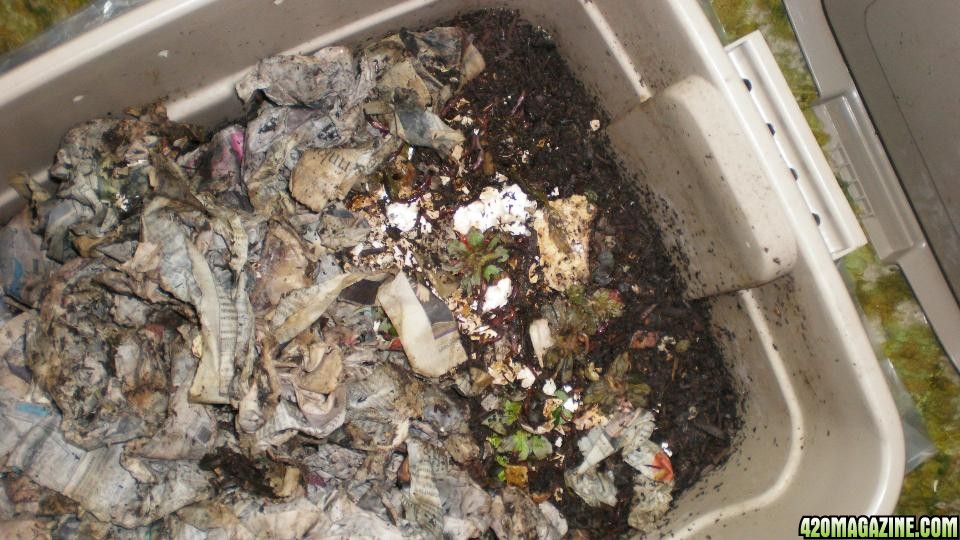Re: Atrain's Going Organic! - Prep & Grow Journal - Empty Compost Bins to Buds in a J
18 Day Compost: The Berkeley Method
Posted on January 26, 2013 | 1 Comment
In the 1970s a formal study was conducted to determine the fastest way to rot organic material. Robert D. Raabe, Professor of Plant Pathology, at the University of California, Berkeley developed what he called the Fast Composting Method, but many call it the Berkeley Method. Raabe discovered that heat-loving bacteria convert plant material to usable compost the fastest, with the most nutrients and fewest harmful elements, like weeds and plant diseases. To attract the right kind of bacteria, a few simple conditions must be met.
The requirements for hot composting using the Berkley method are as follows:
1.Compost temperature is maintained between 55-65 degrees Celsius: This is the ideal range because it is the temperature at which weeds seeds and pathogens will be killed. The hotter the compost, the darker your compost will become. Most importantly this is the ideal temperature range where the compost will get most diversity of life.
2.The C:N (carbon:nitrogen) balance in the composting materials is approximately 25-30:1. It is important that you find what combinations 18 Day Compost: The Berkeley Method
Posted on January 26, 2013 | 1 Comment
In the 1970s a formal study was conducted to determine the fastest way to rot organic material. Robert D. Raabe, Professor of Plant Pathology, at the University of California, Berkeley developed what he called the Fast Composting Method, but many call it the Berkeley Method. Raabe discovered that heat-loving bacteria convert plant material to usable compost the fastest, with the most nutrients and fewest harmful elements, like weeds and plant diseases. To attract the right kind of bacteria, a few simple conditions must be met.
The requirements for hot composting using the Berkley method are as follows:
1.Compost temperature is maintained between 55-65 degrees Celsius: This is the ideal range because it is the temperature at which weeds seeds and pathogens will be killed. The hotter the compost, the darker your compost will become. Most importantly this is the ideal temperature range where the compost will get most diversity of life.
2.The C:N (carbon:nitrogen) balance in the composting materials is approximately 25-30:1. It is important that you find what combinations you can make your compost heap out of. (See Carbon to Nitrogen list)
3.The compost heap needs to be roughly 1.5m high. This is important because a higher heap will create compaction in the middle which will result in anaerobic decomposition. If you want to make more, make the heap as long as you want, but keep the height the same.
4.If composting material is high in carbon, such as tree branches, they need to be broken up, such as with a mulcher.
5.Compost is turned from outside to inside and vice versa to mix it thoroughly.
What do you need?
A pitch fork, a rake and a plastic cover.
activator (optional): They will make the compost decompose faster. Some are high in minerals, others in nitrogen compounds, all stimulate fast and diverse life cycles in your compost heap. Activators can be: Urine, blood, animal or fish remains, comfrey, nettles, yarrow, or a handful of good compost.
With the 18 day Berkley method, the procedure is quite straightforward:
1.Build compost heap
2.4days – no turning
3.Then turn every 2nd day for 14 days
With 1/3 manure, 1/3 greens, 1/3 dry materials, alternate layers of each onto a ground layer of small sticks and twigs. If you are using and activator dont forget to put in in the middle of your heap.
Saturate your heap with water until moisture content of a sample barely drips when squeezed. Then put sticks on top of your pile so that when you put the plastic cover it doesn’t stick to the pile.
This is your starting point, leave the pile in a shaded area if you can (if in the sun check moisture content) – Leave the pile for 4 days.
On day 4: This is your first turning over. You need to peel off the outer layer, which will now become the center of the heap, and the inner layer of the heap become the outer layer. Again check the moisture content and cover.
Two days later on day 6: Turn the pile again like on day 4. Cover.
Two day later on day 8: This is the hottest the compost heap should ever get. If you have a thermometer, check that our heap is between the range of 55 and 65 degrees Celsius. If you don’t have one, there is a simple trick you can do to find out. Stick your arm in the heap until your elbow, if you can do it your compost heap is not hot enough. If you can’t, good news you are on the right track. Turn the pile for the 3rd time and cover.
Two days later on day 10: Turn the heap, you should be noticing that your heap has gotten cooler, this is normal. The compost heap will continue to get cooler everyday from this day onwards
Day 12: you should be turning the pile for the 5th time now. Cover.
Day 14: Turn again.
Day 16: And again, this is your last time turning the pile.
Day 18: The compost heap should be the same size as when started, just warm and have a nice small, dark crown color, with just a few chunks here and there.
What do you do on day 8 if temperature range is not reached?
Ask yourself these questions if your compost heap is not hot enough on day 8:

Is my compost heap big enough?

Is it too wet? too dry?

Is my nitrogen to carbon ratio wrong? too big chunks?
What happened? You probably added too much water, in which case you need to cut your heap into 2, like making a chimney to facilitate evaporation. You might have not put enough water in which case you need to add some. If not too dry or too wet, you probably put in too much carbon and need to balance it out with some more nitrogen content.
Ask yourself these questions if your compost heap is too hot on day 8:

Nitrogen levels too high?

Does it smell bad? (nitrification)

Is it dropping in volume very fast?
What happened? You probably added too much nitrogen, you need to add more carbon material to heap to balance it out as carbon acts like a sponge
Remember any mistake you do in the process will take you back 2 days in the overall process
found this hiding ,looks promising what do u guys think









 Is my compost heap big enough?
Is my compost heap big enough? I've listened to about 50 of his podcasts.
I've listened to about 50 of his podcasts.